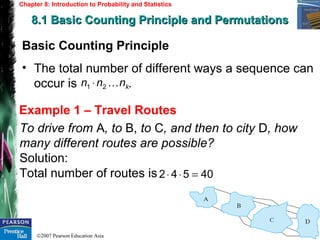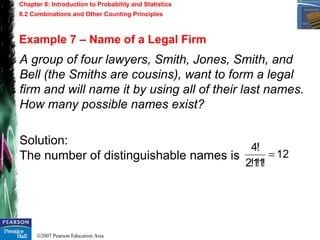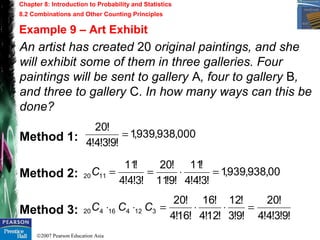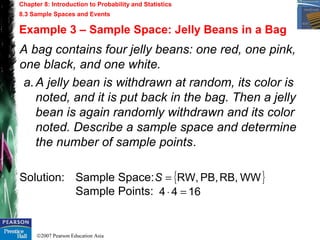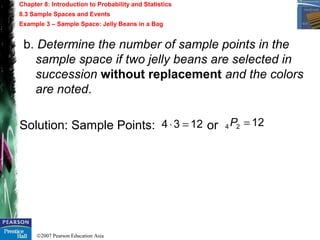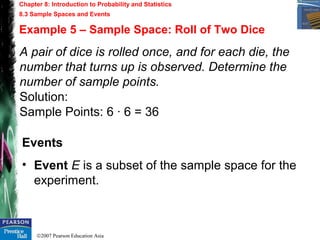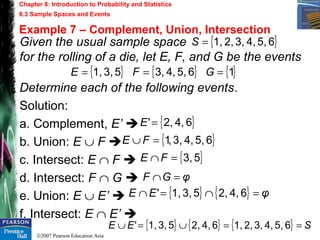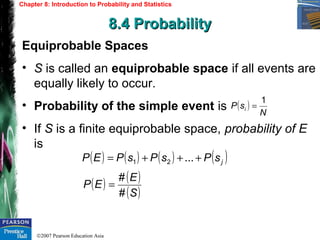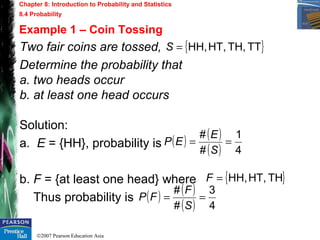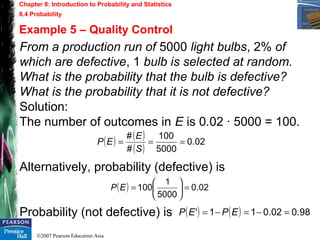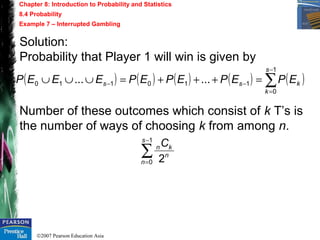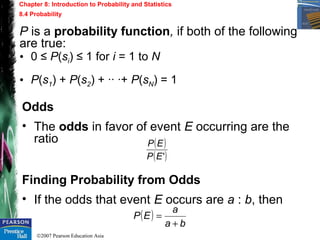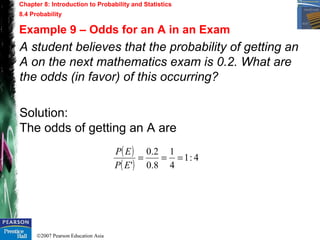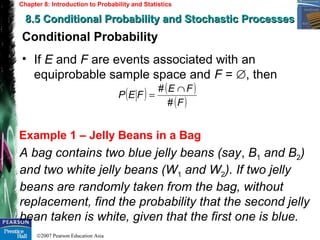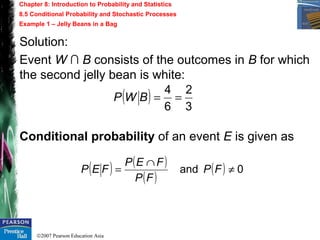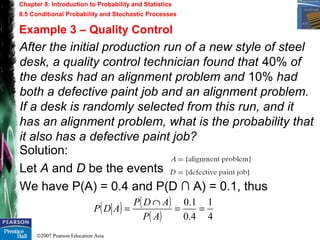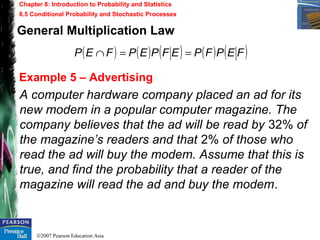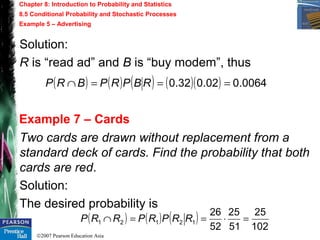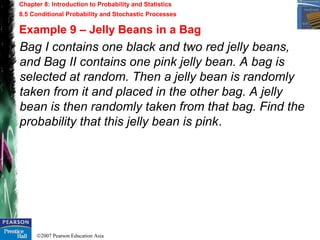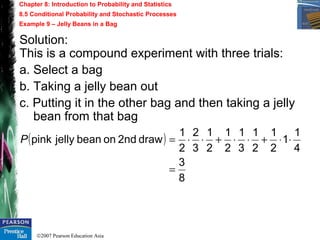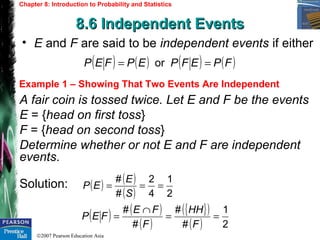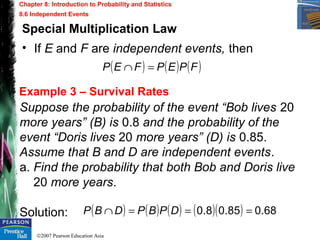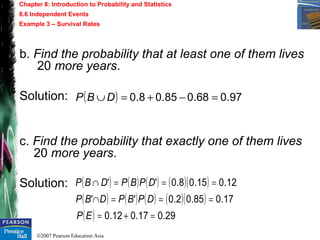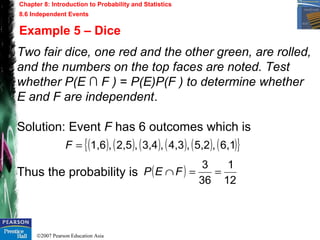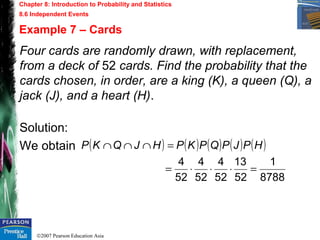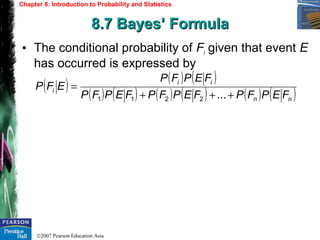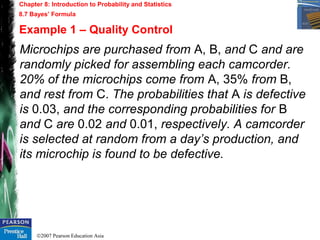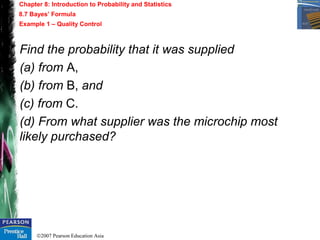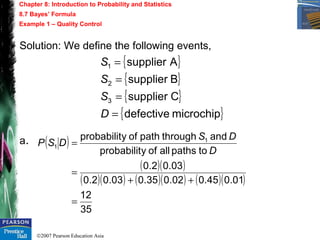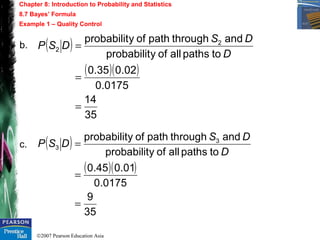Chapter 8 - Introduction to Probability and Statistics
- 1. INTRODUCTORY MATHEMATICALINTRODUCTORY MATHEMATICAL ANALYSISANALYSISFor Business, Economics, and the Life and Social Sciences ©2007 Pearson Education Asia Chapter 8Chapter 8 Introduction to Probability and StatisticsIntroduction to Probability and Statistics
- 2. ©2007 Pearson Education Asia INTRODUCTORY MATHEMATICAL ANALYSIS 0. Review of Algebra 1. Applications and More Algebra 2. Functions and Graphs 3. Lines, Parabolas, and Systems 4. Exponential and Logarithmic Functions 5. Mathematics of Finance 6. Matrix Algebra 7. Linear Programming 8. Introduction to Probability and Statistics
- 3. ©2007 Pearson Education Asia 9. Additional Topics in Probability 10. Limits and Continuity 11. Differentiation 12. Additional Differentiation Topics 13. Curve Sketching 14. Integration 15. Methods and Applications of Integration 16. Continuous Random Variables 17. Multivariable Calculus INTRODUCTORY MATHEMATICAL ANALYSIS
- 4. ©2007 Pearson Education Asia • To develop and apply a Basic Counting Principle. • Combinations and permutations. • To determine a sample space. • To define what is meant by the probability of an event. • To discuss conditional probability. • To develop the notion of independent events. • To develop Bayes’s formula. Chapter 8: Introduction to Probability and Statistics Chapter ObjectivesChapter Objectives
- 5. ©2007 Pearson Education Asia Basic Counting Principle and Permutations Combinations and Other Counting Principles Sample Spaces and Events Probability Conditional Probability and Stochastic Processes Independent Events Bayes’ Formula 8.1) 8.2) 8.3) 8.4) Chapter 8: Introduction to Probability and Statistics Chapter OutlineChapter Outline 8.5) 8.6) 8.7)
- 6. ©2007 Pearson Education Asia Chapter 8: Introduction to Probability and Statistics 8.1 Basic Counting Principle and Permutations8.1 Basic Counting Principle and Permutations Example 1 – Travel Routes Basic Counting Principle • The total number of different ways a sequence can occur is .knnn 21 ⋅ To drive from A, to B, to C, and then to city D, how many different routes are possible? Solution: Total number of routes is 40542 =⋅⋅
- 7. ©2007 Pearson Education Asia Chapter 8: Introduction to Probability and Statistics 8.1 Basic Counting Principle and Permutations Example 3 – Answering a Quiz In how many different ways can a quiz be answered under each of the following conditions? a. The quiz consists of three multiple-choice questions with four choices for each. Solution: b. The quiz consists of three multiple-choice questions (with four choices for each) and five true–false questions. Solution: 644444 3 ==⋅⋅ ( )( ) 20482422222444 53 =⋅=⋅⋅⋅⋅⋅⋅
- 8. ©2007 Pearson Education Asia Chapter 8: Introduction to Probability and Statistics 8.1 Basic Counting Principle and Permutations Permutations • An ordered selection of r objects, without repetition, is a permutation of n objects, taken r at a time. • The number of permutations is denoted nPr .
- 9. ©2007 Pearson Education Asia Chapter 8: Introduction to Probability and Statistics 8.1 Basic Counting Principle and Permutations Example 5 – Club Officers A club has 20 members. The offices of president, vice president, secretary, and treasurer are to be filled. No member may serve in more than one office. How many different slates of candidates are possible? Solution 1: Solution 2: ( )( ) ( )121 +−−−= rnnnnPrn ( ) 280,11617181920 !16 !1617181920 !16 !20 !420 !20 420 =⋅⋅⋅= ⋅⋅⋅⋅ == − =P 280,11617181920420 =⋅⋅⋅=P
- 10. ©2007 Pearson Education Asia Chapter 8: Introduction to Probability and Statistics 8.1 Basic Counting Principle and Permutations Example 7 – Name of a Legal Firm • The number of permutations of n objects taken all at a time is . Lawyers Smith, Jones, Jacobs, and Bell want to form a legal firm and will name it by using all four of their last names. How many possible names are there? Solution: Possible names for the firm, ( ) ! 1 ! !0 ! ! ! n nn nn n Pnn === − = 241234!4 =⋅⋅⋅=
- 11. ©2007 Pearson Education Asia Chapter 8: Introduction to Probability and Statistics 8.2 Combinations and Other Counting Principles8.2 Combinations and Other Counting Principles Example 1 – Comparing Combinations and Permutations Combinations • A combination of n objects taken r at a time is denoted by List all combinations and all permutations of the four letters when they are taken three at a time. Solution: Combinations: Permutations: 24 ( )!! ! rnr n Crn − = 434 =C
- 12. ©2007 Pearson Education Asia Chapter 8: Introduction to Probability and Statistics 8.2 Combinations and Other Counting Principles Example 3 – Poker Hand Example 5 – A Basic Combinatorial Identity A poker hand consists of 5 cards dealt from an ordinary deck of 52 cards. How many different poker hands are there? Solution: Number of possible hands, ( ) 960,598,2 !47!5 !52 !552!5 !52 552 == − =C Establish the identity Solution: 111 +++ =+ rnrnrn CCC ( ) ( ) ( ) ( ) ( ) ( ) ( )( ) 11 1 !11!1 !1 !1!1 ! !! ! ++ + = +−++ + = −−+ + − =+ rn rnrn C rnr n rnr n rnr n CC
- 13. ©2007 Pearson Education Asia Chapter 8: Introduction to Probability and Statistics 8.2 Combinations and Other Counting Principles Permutations with Repeated Objects • The number of distinguishable permutations such that n1 are of one type, n2 are of a second type, …, and nk are of a kth type, where n1 + n2 + … + nk = n, is !!...! ! 21 knnn n
- 14. ©2007 Pearson Education Asia Chapter 8: Introduction to Probability and Statistics 8.2 Combinations and Other Counting Principles Example 7 – Name of a Legal Firm A group of four lawyers, Smith, Jones, Smith, and Bell (the Smiths are cousins), want to form a legal firm and will name it by using all of their last names. How many possible names exist? Solution: The number of distinguishable names is 12 !1!1!2 !4 =
- 15. ©2007 Pearson Education Asia Chapter 8: Introduction to Probability and Statistics 8.2 Combinations and Other Counting Principles Example 9 – Art Exhibit An artist has created 20 original paintings, and she will exhibit some of them in three galleries. Four paintings will be sent to gallery A, four to gallery B, and three to gallery C. In how many ways can this be done? Method 1: Method 2: Method 3: 000,938,939,1 !9!3!4!4 !20 = 00,938,939,1 !3!4!4 !11 !9!11 !20 !3!4!4 !11 1120 =⋅==C !9!3!4!4 !20 !9!3 !12 !12!4 !16 !16!4 !20 312416420 =⋅⋅=⋅⋅ CCC
- 16. ©2007 Pearson Education Asia Chapter 8: Introduction to Probability and Statistics 8.3 Sample Spaces and Events8.3 Sample Spaces and Events Example 1 – Sample Space: Toss of Two Coins Sample Spaces • A sample space S is the set of all possible outcomes. • The number of sample points is denoted #(S). Two different coins are tossed, and the result (H or T) for each coin is observed. Determine a sample space. Solution: { }TTTH,HT,HH,=S
- 17. ©2007 Pearson Education Asia Chapter 8: Introduction to Probability and Statistics 8.3 Sample Spaces and Events Example 3 – Sample Space: Jelly Beans in a Bag A bag contains four jelly beans: one red, one pink, one black, and one white. a.A jelly bean is withdrawn at random, its color is noted, and it is put back in the bag. Then a jelly bean is again randomly withdrawn and its color noted. Describe a sample space and determine the number of sample points. Solution: Sample Space: Sample Points: { }WWRB,PB,RW,=S 1644 =⋅
- 18. ©2007 Pearson Education Asia Chapter 8: Introduction to Probability and Statistics 8.3 Sample Spaces and Events Example 3 – Sample Space: Jelly Beans in a Bag b. Determine the number of sample points in the sample space if two jelly beans are selected in succession without replacement and the colors are noted. Solution: Sample Points: or1234 =⋅ 1224 =P
- 19. ©2007 Pearson Education Asia Chapter 8: Introduction to Probability and Statistics 8.3 Sample Spaces and Events Example 5 – Sample Space: Roll of Two Dice A pair of dice is rolled once, and for each die, the number that turns up is observed. Determine the number of sample points. Solution: Sample Points: 6 · 6 = 36 Events • Event E is a subset of the sample space for the experiment.
- 20. ©2007 Pearson Education Asia Chapter 8: Introduction to Probability and Statistics 8.3 Sample Spaces and Events Example 7 – Complement, Union, Intersection Given the usual sample space for the rolling of a die, let E, F, and G be the events Determine each of the following events. Solution: a. Complement, E’ b. Union: E ∪ F c. Intersect: E ∩ F d. Intersect: F ∩ G e. Union: E ∪ E’ f. Intersect: E ∩ E’ { }65,4,3,2,1,=S { } { } { }165,4,3,53,1, === GFE { }64,2,'=E { }65,4,3,,1=∪ FE { }53,=∩ FE φGF =∩ { } { } { } SEE ==∪=∪ 65,4,3,2,1,64,2,53,1,' { } { } φEE =∩=∩ 64,2,53,1,'
- 21. ©2007 Pearson Education Asia Chapter 8: Introduction to Probability and Statistics 8.3 Sample Spaces and Events Properties of Events
- 22. ©2007 Pearson Education Asia Chapter 8: Introduction to Probability and Statistics 8.4 Probability8.4 Probability Equiprobable Spaces • S is called an equiprobable space if all events are equally likely to occur. • Probability of the simple event is • If S is a finite equiprobable space, probability of E is ( ) N sP i 1 = ( ) ( ) ( ) ( )jsPsPsPEP +++= ...21 ( ) ( ) ( )S E EP # # =
- 23. ©2007 Pearson Education Asia Chapter 8: Introduction to Probability and Statistics 8.4 Probability Example 1 – Coin Tossing Two fair coins are tossed, Determine the probability that a. two heads occur b. at least one head occurs Solution: a. E = {HH}, probability is b. F = {at least one head} where Thus probability is ( ) ( ) ( ) 4 1 # # == S E EP { }TTTH,HT,HH,=S { }THHT,HH,=F ( ) ( ) ( ) 4 3 # # == S F FP
- 24. ©2007 Pearson Education Asia Chapter 8: Introduction to Probability and Statistics 8.4 Probability Example 3 – Full House Poker Hand Find the probability of being dealt a full house in a poker game. A full house is three of one kind and two of another, such as three queens and two 10’s. Express your answer in terms of nCr . Solution: ( ) ( ) ( ) 553 2434 1213 # # housefull C CC S E P ⋅⋅⋅ ==
- 25. ©2007 Pearson Education Asia Chapter 8: Introduction to Probability and Statistics 8.4 Probability Example 5 – Quality Control From a production run of 5000 light bulbs, 2% of which are defective, 1 bulb is selected at random. What is the probability that the bulb is defective? What is the probability that it is not defective? Solution: The number of outcomes in E is 0.02 · 5000 = 100. Alternatively, probability (defective) is Probability (not defective) is ( ) ( ) ( ) 02.0 5000 100 # # === S E EP ( ) 02.0 5000 1 100 = =EP ( ) ( ) 98.002.011' =−=−= EPEP
- 26. ©2007 Pearson Education Asia Chapter 8: Introduction to Probability and Statistics 8.4 Probability Example 7 – Interrupted Gambling Obtain Pascal and Fermat’s solution to the problem of dividing the pot between two gamblers in an interrupted game of chance, as described in the introduction to this chapter. Recall that when the game was interrupted, Player 1 needed r more “rounds” to win the pot outright and that Player 2 needed s more rounds to win. It is agreed that the pot should be divided so that each player gets the value of the pot multiplied by the probability that he or she would have won an uninterrupted game.
- 27. ©2007 Pearson Education Asia Chapter 8: Introduction to Probability and Statistics 8.4 Probability Example 7 – Interrupted Gambling Solution: Probability that Player 1 will win is given by Number of these outcomes which consist of k T’s is the number of ways of choosing k from among n. ( ) ( ) ( ) ( ) ( )∑ − = −− =+++=∪∪∪ 1 0 110110 ...... s k kss EPEPEPEPEEEP ∑ − = 1 0 2 s n n knC
- 28. ©2007 Pearson Education Asia Chapter 8: Introduction to Probability and Statistics 8.4 Probability P is a probability function, if both of the following are true: Odds • The odds in favor of event E occurring are the ratio Finding Probability from Odds • If the odds that event E occurs are a : b, then ( ) ( )'EP EP ( ) ba a EP + = • 0 ≤ P(si) ≤ 1 for i = 1 to N • P(s1) + P(s2) + ·· ·+ P(sN) = 1
- 29. ©2007 Pearson Education Asia Chapter 8: Introduction to Probability and Statistics 8.4 Probability Example 9 – Odds for an A in an Exam A student believes that the probability of getting an A on the next mathematics exam is 0.2. What are the odds (in favor) of this occurring? Solution: The odds of getting an A are ( ) ( ) 4:1 4 1 8.0 2.0 ' === EP EP
- 30. ©2007 Pearson Education Asia Chapter 8: Introduction to Probability and Statistics 8.5 Conditional Probability and Stochastic Processes8.5 Conditional Probability and Stochastic Processes Example 1 – Jelly Beans in a Bag Conditional Probability • If E and F are events associated with an equiprobable sample space and F = , then∅ ( ) ( ) ( )F FE FEP # # ∩ = A bag contains two blue jelly beans (say, B1 and B2) and two white jelly beans (W1 and W2). If two jelly beans are randomly taken from the bag, without replacement, find the probability that the second jelly bean taken is white, given that the first one is blue.
- 31. ©2007 Pearson Education Asia Chapter 8: Introduction to Probability and Statistics 8.5 Conditional Probability and Stochastic Processes Example 1 – Jelly Beans in a Bag Solution: Event W ∩ B consists of the outcomes in B for which the second jelly bean is white: ( ) 3 2 6 4 ==BWP Conditional probability of an event E is given as ( ) ( ) ( ) ( ) 0and ≠ ∩ = FP FP FEP FEP
- 32. ©2007 Pearson Education Asia Chapter 8: Introduction to Probability and Statistics 8.5 Conditional Probability and Stochastic Processes Example 3 – Quality Control After the initial production run of a new style of steel desk, a quality control technician found that 40% of the desks had an alignment problem and 10% had both a defective paint job and an alignment problem. If a desk is randomly selected from this run, and it has an alignment problem, what is the probability that it also has a defective paint job? Solution: Let A and D be the events We have P(A) = 0.4 and P(D ∩ A) = 0.1, thus ( ) ( ) ( ) 4 1 4.0 1.0 == ∩ = AP ADP ADP
- 33. ©2007 Pearson Education Asia Chapter 8: Introduction to Probability and Statistics 8.5 Conditional Probability and Stochastic Processes Example 5 – Advertising A computer hardware company placed an ad for its new modem in a popular computer magazine. The company believes that the ad will be read by 32% of the magazine’s readers and that 2% of those who read the ad will buy the modem. Assume that this is true, and find the probability that a reader of the magazine will read the ad and buy the modem. General Multiplication Law ( ) ( ) ( ) ( ) ( )FEPFPEFPEPFEP ==∩
- 34. ©2007 Pearson Education Asia Chapter 8: Introduction to Probability and Statistics 8.5 Conditional Probability and Stochastic Processes Example 5 – Advertising Example 7 – Cards Solution: R is “read ad” and B is “buy modem”, thus ( ) ( ) ( ) ( )( ) 0064.002.032.0 ===∩ RBPRPBRP Two cards are drawn without replacement from a standard deck of cards. Find the probability that both cards are red. Solution: The desired probability is ( ) ( ) ( ) 102 25 51 25 52 26 12121 =⋅==∩ RRPRPRRP
- 35. ©2007 Pearson Education Asia Chapter 8: Introduction to Probability and Statistics 8.5 Conditional Probability and Stochastic Processes Example 9 – Jelly Beans in a Bag Bag I contains one black and two red jelly beans, and Bag II contains one pink jelly bean. A bag is selected at random. Then a jelly bean is randomly taken from it and placed in the other bag. A jelly bean is then randomly taken from that bag. Find the probability that this jelly bean is pink.
- 36. ©2007 Pearson Education Asia Chapter 8: Introduction to Probability and Statistics 8.5 Conditional Probability and Stochastic Processes Example 9 – Jelly Beans in a Bag Solution: This is a compound experiment with three trials: a. Select a bag b. Taking a jelly bean out c. Putting it in the other bag and then taking a jelly bean from that bag ( ) 8 3 4 1 1 2 1 2 1 3 1 2 1 2 1 3 2 2 1 draw2ndonbeanjellypink = ⋅⋅+⋅⋅+⋅⋅=P
- 37. ©2007 Pearson Education Asia Chapter 8: Introduction to Probability and Statistics 8.6 Independent Events8.6 Independent Events Example 1 – Showing That Two Events Are Independent • E and F are said to be independent events if either A fair coin is tossed twice. Let E and F be the events E = {head on first toss} F = {head on second toss} Determine whether or not E and F are independent events. Solution: ( ) ( ) ( ) ( )FPEFPEPFEP == or ( ) ( ) ( ) 2 1 4 2 # # === S E EP ( ) ( ) ( ) { }( ) ( ) 2 1 # # # # == ∩ = F HH F FE FEP
- 38. ©2007 Pearson Education Asia Chapter 8: Introduction to Probability and Statistics 8.6 Independent Events Example 3 – Survival Rates Special Multiplication Law • If E and F are independent events, then Suppose the probability of the event “Bob lives 20 more years” (B) is 0.8 and the probability of the event “Doris lives 20 more years” (D) is 0.85. Assume that B and D are independent events. a. Find the probability that both Bob and Doris live 20 more years. Solution: ( ) ( ) ( )FPEPFEP =∩ ( ) ( ) ( ) ( )( ) 68.085.08.0 ===∩ DPBPDBP
- 39. ©2007 Pearson Education Asia Chapter 8: Introduction to Probability and Statistics 8.6 Independent Events Example 3 – Survival Rates b. Find the probability that at least one of them lives 20 more years. Solution: c. Find the probability that exactly one of them lives 20 more years. Solution: ( ) 97.068.085.08.0 =−+=∪DBP ( ) ( ) ( ) ( )( ) 17.085.02.0'' ===∩ DPBPDBP ( ) 29.017.012.0 =+=EP ( ) ( ) ( ) ( )( ) 12.015.08.0'' ===∩ DPBPDBP
- 40. ©2007 Pearson Education Asia Chapter 8: Introduction to Probability and Statistics 8.6 Independent Events Example 5 – Dice Two fair dice, one red and the other green, are rolled, and the numbers on the top faces are noted. Test whether P(E ∩ F ) = P(E)P(F ) to determine whether E and F are independent. Solution: Event F has 6 outcomes which is Thus the probability is ( ) ( ) ( ) ( ) ( ) ( ){ }6,1,5,2,4,3,3,4,2,5,1,6=F ( ) 12 1 36 3 ==∩FEP
- 41. ©2007 Pearson Education Asia Chapter 8: Introduction to Probability and Statistics 8.6 Independent Events Example 7 – Cards Four cards are randomly drawn, with replacement, from a deck of 52 cards. Find the probability that the cards chosen, in order, are a king (K), a queen (Q), a jack (J), and a heart (H). Solution: We obtain ( ) ( ) ( ) ( ) ( ) 8788 1 52 13 52 4 52 4 52 4 =⋅⋅⋅= =∩∩∩ HPJPQPKPHJQKP
- 42. ©2007 Pearson Education Asia Chapter 8: Introduction to Probability and Statistics 8.7 Bayes’ Formula8.7 Bayes’ Formula • The conditional probability of Fi given that event E has occurred is expressed by ( ) ( ) ( ) ( ) ( ) ( ) ( ) ( ) ( )nn ii i FEPFPFEPFPFEPFP FEPFP EFP +++ = ...2211
- 43. ©2007 Pearson Education Asia Chapter 8: Introduction to Probability and Statistics 8.7 Bayes’ Formula Example 1 – Quality Control Microchips are purchased from A, B, and C and are randomly picked for assembling each camcorder. 20% of the microchips come from A, 35% from B, and rest from C. The probabilities that A is defective is 0.03, and the corresponding probabilities for B and C are 0.02 and 0.01, respectively. A camcorder is selected at random from a day’s production, and its microchip is found to be defective.
- 44. ©2007 Pearson Education Asia Chapter 8: Introduction to Probability and Statistics 8.7 Bayes’ Formula Example 1 – Quality Control Find the probability that it was supplied (a) from A, (b) from B, and (c) from C. (d) From what supplier was the microchip most likely purchased?
- 45. ©2007 Pearson Education Asia Chapter 8: Introduction to Probability and Statistics 8.7 Bayes’ Formula Example 1 – Quality Control Solution: We define the following events, a. { } { } { } { }microchipdefective Csupplier Bsupplier Asupplier 3 2 1 = = = = D S S S ( ) ( )( ) ( )( ) ( )( ) ( )( ) 35 12 01.045.002.035.003.02.0 03.02.0 topathsallofyprobabilit andthroughpathofyprobabilit 1 1 = ++ = = D DS DSP
- 46. ©2007 Pearson Education Asia Chapter 8: Introduction to Probability and Statistics 8.7 Bayes’ Formula Example 1 – Quality Control b. c. ( ) ( )( ) 35 14 0175.0 02.035.0 topathsallofyprobabilit andthroughpathofyprobabilit 2 2 = = = D DS DSP ( ) ( )( ) 35 9 0175.0 01.045.0 topathsallofyprobabilit andthroughpathofyprobabilit 3 3 = = = D DS DSP






